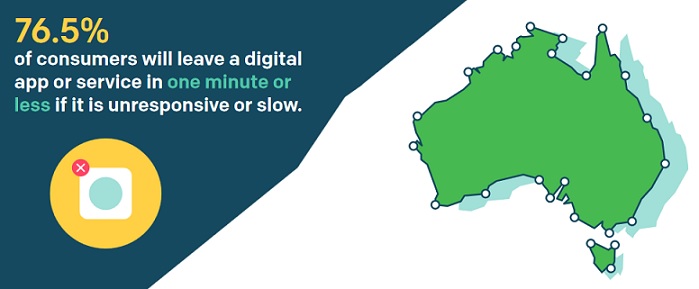
More than three quarters of Australian consumers will leave a digital (website or mobile) app or service in one minute or less if it is unresponsive or slow, according to a new survey from PagerDuty.
The State of Digital Operations Report highlighted a disconnect between consumers’ high expectations of their digital service experience and how quickly IT organizations can adapt to the rise of digital service offerings and resolve customer-impacting incidents.

The survey also indicated that ensuring excellent digital experiences is no longer just an imperative for the developers and IT operations teams responsible for managing infrastructure. Digital incidents now have a direct impact on the business, with nearly one third of respondents reporting that one hour of IT downtime costs their companies between $500,000 to more than $10 million AUD. Of the IT organizations that felt prepared to effectively support digital offerings, incident management reigned supreme, with DevOps, continuous integration, agile development and ChatOps identified as other common practices.
The report findings, based on a two-part survey of over 200 IT personnel in development and operations as well as over 300 consumers in Australia, revealed that resolving consumer-impacting incidents takes IT teams at least five times longer than the amount of time consumers are willing to wait for a service that isn’t performing properly — increasing the chances that customers and revenue are lost during downtime. Nearly all (90 percent) of the IT professionals (e.g., developers, DevOps and IT operations teams) surveyed cited that IT operations is most responsible for ensuring seamless delivery of their organization’s digital offerings, ultimately holding the key to consumers’ brand loyalty and business revenue.
“Digital services provide an essential way for consumers to complete everyday tasks and as a result, expectations for an always-on, user-friendly digital experience have reached new heights,” said Jennifer Tejada, CEO, PagerDuty. “To meet this demand and remain competitive, businesses must integrate machine and human intelligence with incident response best practices to enable effective business-wide response, leveraging the excellence of digital operations management. The alternative could mean a loss of customers and millions in revenue.”
In the survey, digital services were defined as those offered through digital interfaces, such as computers, tablets and smartphones, spanning both professional services, as well as those used for personal reasons. These services have become more prevalent in the lives of Australian consumers — Deloitte Access Economics (2015) estimates that the broader digital economy will grow to contribute as much as $139 billion to the economy by 2020 (7.3% of GDP).
The Business Impact of IT Incidents
IT incidents impact more than IT organizations. The report found that IT incidents also have a direct impact on stakeholders in the lines of business:
■ Nearly one third of respondents (33.4 percent) report that one hour of IT downtime costs their companies between $500,000 to more than $10 million AUD.
■ The non-IT departments most impacted by IT Operations issues are sales, research and development, accounting and finance, marketing, customer service and production.
■ Despite IT incidents becoming increasingly tied to business success and the bottom line, only 21.4 percent of organizations prioritize informing business stakeholders after a disruption occurs.
■ Less than half of organizations (44.3 percent) contact affected customers or users.
The IT Readiness Disconnect
The survey of over 200 IT personnel in development and operations found that while a majority feel confident that their organization is prepared to support digital services, more than half are still experiencing customer-impacting incidents (slowness or downtime) at least one or more times per week.
■ 71.9 percent of respondents feel confident that their IT organization is prepared to support digital services.
■ 56.2 percent of respondents noted that their organizations are still experiencing customer-impacting incidents (slowness or downtime) at least one or more times a week.
The rise in digital service offerings has also created operations challenges for IT organizations such as increased difficulty in capacity planning (e.g. increase in volume of data), increased complexity resulting in more cognitive load and an increase in number of tools. IT organizations also face reduced budgets, lack of full stack visibility, lack of contextual data when troubleshooting, siloed IT functions limiting collaboration and alert fatigue.
The Cure for the Common Digital Disruption Challenge
Many IT professionals are adopting modern development methods and tools to address the challenges of digital operations and consumer expectations:
■ According to IT organizations, incident management reigns supreme among those who feel prepared to effectively support digital offerings, with DevOps, continuous integration, agile development and ChatOps identified as other common practices.
■ Monitoring tools also play a critical role in helping organizations support digital service offerings effectively. Security monitoring is the tool or service most widely used among organizations who feel they’re equipped to support digital services, followed by application monitoring, infrastructure monitoring and IT operations analytics.
“Today’s IT teams are faced with more complex architectures that result in a number of new operational and technological challenges. The number of tools used, coupled with the increase in volume of data in play, makes it even more difficult to ensure a consistent digital experience for customers,” said David Wall, Managing Director and Country Manager for APAC, PagerDuty. “As organizations bridge between IT performance and a superior digital experience, their IT teams and lines of business must be equipped with digital operations tools and services that enable even more visibility into the digital stack.”
